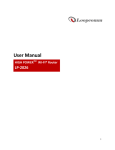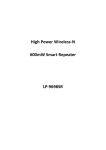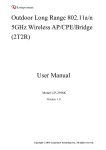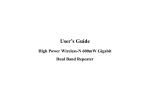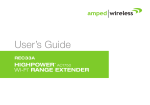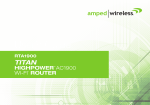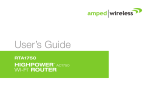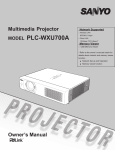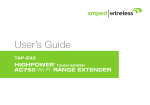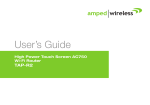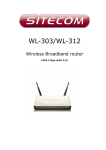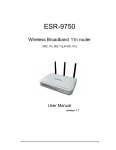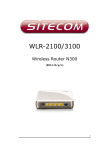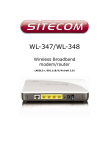Download User Manual 802.11AC Dual Band Wireless Router
Transcript
User Manual 802.11AC Dual Band Wireless Router Model: LP-8096 Copyright © 2014 Loopcomm Technology Inc. All rights reserved. Table of Contents Notice..................................................................................................................................................................................................................1 Scenario.............................................................................................................................................................................................................2 Features .............................................................................................................................................................................................................3 Technical Specification ................................................................................................................................................................................4 Getting Started ...............................................................................................................................................................................................5 Package Contents ............................................................................................................................................................................................ 5 LED Indicators ................................................................................................................................................................................................ 6 Back Panel Description ................................................................................................................................................................................... 7 Setup Guide .................................................................................................................................................................................................... 8 Software Configuration.............................................................................................................................................................................12 5.0GHz WiFi Settings ................................................................................................................................................................................... 20 Basic Settings (5.0GHz)............................................................................................................................................................................ 20 Security (5.0GHz) ..................................................................................................................................................................................... 22 Advanced Settings (5.0GHz) ..................................................................................................................................................................... 23 Wi-Fi Protected Setup – WPS (5.0GHz).................................................................................................................................................... 24 Wireless Coverage Controls (5.0GHz) ...................................................................................................................................................... 25 Access Schedule (5.0GHz)........................................................................................................................................................................ 26 Copyright © 2014 Loopcomm Technology Inc. All rights reserved. 2.4GHz WiFi Settings.................................................................................................................................................................................... 27 Basic Settings (2.4GHz) ............................................................................................................................................................................ 27 Security (2.4GHz) ..................................................................................................................................................................................... 29 Advanced Settings (2.4GHz) ..................................................................................................................................................................... 30 Wi-Fi Protected Setup – WPS (2.4GHz).................................................................................................................................................... 31 Wireless Coverage Controls (2.4GHz) ...................................................................................................................................................... 32 Access Schedule (2.4GHz) ........................................................................................................................................................................ 33 Network Settings ........................................................................................................................................................................................... 34 Local Network (LAN) ................................................................................................................................................................................... 34 Internet Network (WAN) .......................................................................................................................................................................... 36 Advanced Settings .................................................................................................................................................................................... 38 Smart Features .............................................................................................................................................................................................. 39 Block Websites ......................................................................................................................................................................................... 40 User Access (MAC Address Filtering) ...................................................................................................................................................... 41 User Access (IP Address Filtering) ............................................................................................................................................................ 42 USB Storage .................................................................................................................................................................................................43 Local Sharing ........................................................................................................................................................................................... 43 FTP Server ................................................................................................................................................................................................ 44 Firewall Settings ........................................................................................................................................................................................... 45 Port Filtering............................................................................................................................................................................................. 45 Copyright © 2014 Loopcomm Technology Inc. All rights reserved. Port Forwarding ........................................................................................................................................................................................ 46 DMZ (Demilitarized Zone) ....................................................................................................................................................................... 47 Virtual LAN .............................................................................................................................................................................................. 48 Quality of Service ......................................................................................................................................................................................... 50 Routing Setup................................................................................................................................................................................................ 51 Management.................................................................................................................................................................................................. 52 System Status............................................................................................................................................................................................ 52 Network Statistics ..................................................................................................................................................................................... 54 Dynamic DNS Settings ............................................................................................................................................................................. 55 System Clock ............................................................................................................................................................................................ 56 System Logs ............................................................................................................................................................................................. 57 Upgrade Firmware .................................................................................................................................................................................... 58 Save/Reload Settings ................................................................................................................................................................................ 59 Password ..................................................................................................................................................................................................60 Appendix .........................................................................................................................................................................................................61 Default Settings ............................................................................................................................................................................................. 62 Copyright © 2014 Loopcomm Technology Inc. All rights reserved. Notice This document is issued to guide users how to install and operate LP-8096 802.11AC Dual Band Wireless Router. Please read the document carefully to avoid any damage which is caused by inappropriate use excluding from the warranty. Loopcomm Technology Inc. reserves the right to revise/update the content of LP-8096 user manual without advance notice. Copyright © 2014 Loopcomm Technology Inc. All rights reserved. Scenario Copyright © 2014 Loopcomm Technology Inc. All rights reserved. Features Complies with IEEE 802.11a/b/g/n and ac Draft 2.0 Maximum PHY data rate up to : 173.3Mbps using 20MHz bandwidth, 400Mbps using 40MHz bandwidth, 866.7Mbps using 80MHz bandwidth. 2x2 MIMO technology for extended reception robustness and exceptional throughput 5MHz / 10MHz / 20MHz / 40MHz / 80MHz bandwidth transmission OFDM with BPSK, QPSK, 16QAM, 64QAM and 256QAM modulation. Convolutional Coding Rate: 1/2, 2/3, 3/4, and 5/6 Support Network Attached Storage All Giga RJ45 Ports Support USB2.0 Copyright © 2014 Loopcomm Technology Inc. All rights reserved. Technical Specification Wireless Standard: 802.11a/b/g/n and ac Draft 2.0 Frequency Band: 2.4GHz, 5.0GHz Wireless Speed: 2.4GHz: 300Mbps (Tx/Rx) 5.0GHz: 300Mbps (Tx/Rx) Amplifier: Dual 2.4GHz Amplifiers Dual 5.0GHz Amplifiers Dual Low Noise Amplifier Wireless Sensitivity: -93dBm (Max) Wireless Output Power: 18dBm (Max) Wireless Security: • WEP, WPA, WPA2, WPA Mixed, WPS User Access Control: • MAC address filtering Wireless Access Scheduling: • Specific day and time (2.4GHz or 5.0GHz Separately) Wireless Coverage Control: Antennas: • 2 x Detachable Dual Band 5dBi Omnidirectional Antenna • 2 x Reverse SMA Connector Ports: • 1 x RJ-45 10/100/1000M WAN ports (Local Ports) • 4 x RJ-45 10/100/1000M LAN ports (Local Ports) • USB 2.0 Port for Storage Devices Mounting: • Wall, Stand or Desktop Setup Requirements: • Wired or wireless PC/Mac and an available 802.11a/b/g/n or ac Draft2.0 wireless network • Google Chrome, Internet Explorer (8.0 and up) or Safari Web browser • 15% - 100% Output Power (2.4GHz or 5.0GHz Separately) Copyright © 2014 Loopcomm Technology Inc. All rights reserved. Getting Started Package Contents Check to make sure you have all the contents within your package: 802.11ac Dual Band Wireless Router Two Detachable 5dBi Omnidirectional Antennas Power Adapter (AC 100-240V, DC 5V/2A) Two RJ-45 Ethernet Cable Quick Installation Guide Product CD Stand for Vertical Mounting Copyright © 2014 Loopcomm Technology Inc. All rights reserved. LED Indicators Power: Indicates when the Dual Band Wireless Router is powered on. The LED will remain on. 5.0GHz Wireless Activity: Blinks rapidly when wireless data traffic is transmitted or received over the 5.0GHz wireless network. 2.4GHz Wireless Activity: Blinks rapidly when wireless data traffic is transmitted or received over the2.4GHz wireless network. WPS: Wi-Fi Protected Setup activity. When the WPS mode is activated the WPS LED blinks as it awaits a connection. USB Connection: Indicates when a USB storage device is connected to the USB port for local sharing. Gigabit Wired Ports 1-4: Indicates when a networking device is connected to a wired port on the back of the Dual Band Wireless Router. The LED blinks rapidly when wired data traffic is transmitted or received. Internet Connection: Indicates when the Dual Band Wireless Router is connected to a broadband modem. The LED will blink when Internet traffic is transmitted or received. Copyright © 2014 Loopcomm Technology Inc. All rights reserved. Back Panel Description Antenna Connectors (1-2): SMA antenna connectors. Attach the included high gain dual band antennas to these connectors WPS: Hold down for 3 seconds to enable WPS push button configuration. Reset: Push down once to reboot the Dual Band Wireless Router. Hold down for 5-10 seconds to reset the Dual Band Wireless Router back to factory settings. Power: Power adapter port. AC Input: 100-240V, DC Output: 5V 2A USB Port: Attach USB storage devices, such as USB flash drives and external hard drives, for file sharing. Wired Devices: Gigabit RJ-45 ports for connecting to wired computers or network devices. Modem: RJ-45 port for connecting to your Broadband Modem. Copyright © 2014 Loopcomm Technology Inc. All rights reserved. Setup Guide Setup Preparations 1. Disconnect and Power Off your Existing Wireless Router. 2. Disconnect your existing Wireless Router from your computer, your broadband modem and its power outlet. If you do not have an existing Wireless Router please continue to the next step. Power off your Modem Please Power off the Modem by disconnecting the Modem’s power adapter from the power outlet. If your Modem has a backup battery, remove the backup battery from your Modem. Do NOT power on the Modem until prompted at a later step. Copyright © 2014 Loopcomm Technology Inc. All rights reserved. Connect the Dual Band Wireless Router to your Modem *Do NOT connect the power adapter to the Dual Band Wireless Router at this time a) Use the included Ethernet cable and connect one end of the cable to your Modem b) Connect the other end of the cable to the WAN port on the Dual Band Wireless Router Copyright © 2014 Loopcomm Technology Inc. All rights reserved. Power on your Modem Plug in your Modem’s power adapter and backup battery (if available): Copyright © 2014 Loopcomm Technology Inc. All rights reserved. Power ON the Dual Band Wireless Router and connect it to your Computer a) Attach the antennas of the Dual Band Wireless Router to the antenna ports labeled 1 and 2 b) Connect the included grey network cable to an available port on your computer c) Attach the power adapter to the Dual Band Wireless Router’s PWR port and a power outlet Copyright © 2014 Loopcomm Technology Inc. All rights reserved. Software Configuration Open your Web Browser to Access the Setup Wizard 1. Open your web browser. 2. Type in: http://setup.loopcomm.com into the web address bar. 3. If the web menu fails to open, type in the following IP address into your web address bar: http://192.168.3.1 4. When prompted, enter the login and password. Copyright © 2014 Loopcomm Technology Inc. All rights reserved. Welcome to the Smart Setup Wizard When the web menu appears, click BASIC SETUP and NEXT to proceed with the Smart Setup Wizard. The Smart Setup Wizard will guide you through the following settings: 1. Internet Connection 2. System Clock 3. Wireless Connection Copyright © 2014 Loopcomm Technology Inc. All rights reserved. Configure your Internet Connection Configure your Internet settings using the automatic configuration settings. The wizard will check the connection to your modem and attempt to automatically configure your Internet connection settings. If there is a problem with the connection the wizard will provide you with information regarding the problem. More advanced users may choose to configure their connections manually by selecting Manual Configuration. DSL users may require additional login information. Select the appropriate connection type and enter the required information. Copyright © 2014 Loopcomm Technology Inc. All rights reserved. If the Automatic configuration was successful, you will be directed to a Configuration Successful page. Click Next to continue Copyright © 2014 Loopcomm Technology Inc. All rights reserved. Set the System Clock The System Clock is used for system logs and setting schedules for Internet access. Click Sync to synchronize the System Clock with the time on your computer. Click Next to continue. Copyright © 2014 Loopcomm Technology Inc. All rights reserved. Configure your Wireless Settings The default SSID of the Dual Band Wireless Router is “Loopcomm_5.0GHz” To change it, enter a new name in the SSID field. Users connecting wirelessly to the Dual Band Wireless Router will use this ID to identify your wireless network. The default Security Key (WPA/WPA2) for your wireless network is “wireless”. To change it, enter a new key in the Security Key field. The key must be 8-characters minimum. Click Next to continue. Copyright © 2014 Loopcomm Technology Inc. All rights reserved. The default SSID of the Dual Band Wireless Router is “Loopcomm_2.4GHz” To change it, enter a new name in the SSID field. Users connecting wirelessly to the Dual Band Wireless Router will use this ID to identify your wireless network. The default Security Key (WPA/WPA2) for your wireless network is “wireless”. To change it, enter a new key in the Security Key field. The key must be 8-characters minimum. Click Next to apply your settings. The Dual Band Wireless Router will reboot. This process may take up to 1 minute. The page will automatically reload after the countdown. If it does not, you may need to refresh the page manually or check your connection to the Dual Band Wireless Router. Copyright © 2014 Loopcomm Technology Inc. All rights reserved. Setup Summary Once the Dual Band Wireless Router has rebooted, it will load the Setup Summary page and provide you with the details of your setup. Open a new web browser window and check that you have access to the Internet. At this time, you may disconnect from the Dual Band Wireless Router and start a wireless connection. If you have any wired devices that you would like to attach to the Dual Band Wireless Router you may do so now as well. Enjoy your Loopcomm Wireless network. Copyright © 2014 Loopcomm Technology Inc. All rights reserved. 5.0GHz WiFi Settings Basic Settings (5.0GHz) Disable All Wireless Connections: Disabling Wireless will turn off all Wi-Fi activity. Users will no longer be able to connect wirelessly to your network. Band: Select the compatible Wi-Fi standard and speed for your wireless network Broadcast SSID: Selecting Disable Broadcast SSID will hide the visibility of the Dual Band Wireless Router’s SSID. Users must manually enter the SSID to connect. Data Rate: Sets the maximum wireless data rate that your network will operate on. Wireless Network ID (SSID): The name of your wireless network. Channel Width: Wi-Fi operates in two separate channel widths, 20Hz and 40Hz. 20Hz allows operation on channels 1-11, while 40Hz is 5-11. 40Hz allows for faster speeds. Select the channel width you wish to use for your network. This setting must match that of your Home Network for a successful connection. Channel Number: Wi-Fi networks operate on specific wireless channels. Some network channels may have more interference than others. If your performance is unstable, try a different channel number. If you are using a repeater with this network, it is recommended you set a static channel, instead of using "Auto." WMM: Prioritizes multimedia data over the wireless network. Associated Clients: Shows the active users connected wirelessly to your network Copyright © 2014 Loopcomm Technology Inc. All rights reserved. Guest Networks (5.0GHz) Click “Enable” to create a Guest Network. Guest Networks provide a separate wireless network, with unique settings for users to connect to. Band: Restrict the Wi-Fi protocol and speed used for the specific Guest Network. SSID: This is the name of your Guest Network. Data Rate: Restrict access to the Guest Network by setting a lower bandwidth by changing the data rate. Broadcast SSID: Disable to hide your SSID from public view. Users will need to manually enter the SSID into their wireless software interface to connect. Access: Restrict access for Guest networks to allow Internet only connections and protect your local network. Associated Clients: View all computers and network devices that are connected to your Guest Network wirelessly. To set security settings for the Guest Network go to: 5.0GHz Wi-Fi Settings > Security. Copyright © 2014 Loopcomm Technology Inc. All rights reserved. Security (5.0GHz) Wireless security allows you to change the type of wireless security settings for your 5.0GHz Network, Home Network or Guest Networks. Note. If you adjust the security of your Home Network and it is incorrect, the Dual Band Wireless Router will no longer have a successful connection to your Home Network. Using the drop down menu, you can select which network you wish to configure and may adjust the security settings below. If you are using the Guest Network feature, you will be able to adjust the security settings for those additional network SSIDs here as well. Copyright © 2014 Loopcomm Technology Inc. All rights reserved. Advanced Settings (5.0GHz) Advanced Wireless Settings should only be adjusted by technically advanced users. It is not recommended that novice users adjust these settings to avoid degrading wireless performance. Here are a few definitions on some settings. Fragment Threshold: The Default and Recommended setting is at 2346, meaning the Dual Band Wireless Router will never fragment any frames that it sends to wireless users. RTS Threshold: Adjusts the size of RTS data packets. Lower values reduce throughput, but allow the system to recover quicker from interference/collisions. Higher values provide the fastest throughput. Beacon Interval: Indicates the frequency interval of the beacon. A beacon is a packet broadcast by the Dual Band Wireless Router to sync the wireless network. Preamble Type: Defines the length of the Cyclic Redundancy Check for communication between the Dual Band Wireless Router and roaming wireless users. IAPP: Inter-Access Point Protocol Aggregation: If it enabled, it will combine of several small data frames to enhance the transmission efficiency. Short GI: If it enabled in 802.11n mode, it will bring the advantage of packet anti-interference. That means the performance will be also greater. WLAN Partition: If it enabled, it will prohibit the communication between clients of LAN. Copyright © 2014 Loopcomm Technology Inc. All rights reserved. STBC: Space Time Block Coding improves reception by coding the data stream in blocks. TX Beamforming: It’s a technique implemented in digital signal processing (DSP) logic to improve range and data rate. Wi-Fi Protected Setup – WPS (5.0GHz) WPS is a Wi-Fi feature created to make Wi-Fi setup simple and easy. Some wireless routers and adapters support this feature with varying names (i.e. one touch setup or WPS). You may enable WPS setup here by selecting the type of WPS setup you wish to use. The Dual Band Wireless Router supports all types of WPS setup: Option A: Push button: You may push the WPS button on the web menu or use the physical button on the back of the Dual Band Wireless Router. Option B: PIN: Some wireless devices use a PIN number to access wireless network. If your wireless device requests for a PIN number, then use the PIN code located here. Option C: Enter PIN: Some wireless devices require that you use a PIN number to add them to the wireless network. Copyright © 2014 Loopcomm Technology Inc. All rights reserved. If your wireless device has a PIN number, then locate the number and enter in the field, then press Start Pin. Wireless Coverage Controls (5.0GHz) Adjust the output power of the Dual Band Wireless Router to control the coverage distance of your 5.0GHz Wireless Network. For a smaller coverage area you can select a lower output power. For the maximum wireless coverage select the 100% selection. Note that if you select a lower output power, your connection to your 5.0GHz Home Network will also decrease in range. It is recommended that you test your signal strength after each adjustment. Copyright © 2014 Loopcomm Technology Inc. All rights reserved. Access Schedule (5.0GHz) Access Schedules will enable or disable your 5.0GHz wireless access at a set time based on your predefined schedule. This feature is often used for restricting access to all users (such as children, employees, guests) during specific times of the day for parental control or security reasons. a. Enable Access Schedule. b. Select which days you wish for your Wi-Fi to be available. c. Select the time frame during that day that you wish for Wi-Fi to be available. d. Apply Changes. Enabling Access Schedule will also disable internet access for wired connections on specified days. Note. Make sure you have already configured your System Clock in order for your schedule to work correctly. Time Zone Settings can be adjusted from the web menu under Management > Time Zone Settings. Copyright © 2014 Loopcomm Technology Inc. All rights reserved. 2.4GHz WiFi Settings Basic Settings (2.4GHz) Disable All Wireless Connections: Disabling Wireless will turn off all Wi-Fi activity. Users will no longer be able to connect wirelessly to your network. Band: Select the compatible Wi-Fi standard and speed for your wireless network Broadcast SSID: Selecting Disable Broadcast SSID will hide the visibility of the Dual Band Wireless Router’s SSID. Users must manually enter the SSID to connect. Data Rate: Sets the maximum wireless data rate that your network will operate on. Wireless Network ID (SSID): The name of your wireless network. Channel Width: Wi-Fi operates in two separate channel widths, 20Hz and 40Hz. 20Hz allows operation on channels 1-11, while 40Hz is 5-11. 40Hz allows for faster speeds. Select the channel width you wish to use for your network. This setting must match that of your Home Network for a successful connection. Channel Number: Wi-Fi networks operate on specific wireless channels. Some network channels may have more interference than others. If your performance is unstable, try a different channel number. If you are using a repeater with this network, it is recommended you set a static channel, instead of using "Auto." WMM: Prioritizes multimedia data over the wireless network. Associated Clients: Shows the active users connected wirelessly to your network Copyright © 2014 Loopcomm Technology Inc. All rights reserved. Guest Networks (2.4GHz) Click “Enable” to create a Guest Network. Guest Networks provide a separate wireless network, with unique settings for users to connect to. Band: Restrict the Wi-Fi protocol and speed used for the specific Guest Network. SSID: This is the name of your Guest Network. Data Rate: Restrict access to the Guest Network by setting a lower bandwidth by changing the data rate. Broadcast SSID: Disable to hide your SSID from public view. Users will need to manually enter the SSID into their wireless software interface to connect. Access: Restrict access for Guest networks to allow Internet only connections and protect your local network. Associated Clients: View all computers and network devices that are connected to your Guest Network wirelessly. To set security settings for the Guest Network go to: 2.4GHz Wi-Fi Settings > Security. Copyright © 2014 Loopcomm Technology Inc. All rights reserved. Security (2.4GHz) Wireless security allows you to change the type of wireless security settings for your 2.4GHz Network, Home Network or Guest Networks. Note. If you adjust the security of your Home Network and it is incorrect, the Dual Band Wireless Router will no longer have a successful connection to your Home Network. Using the drop down menu, you can select which network you wish to configure and may adjust the security settings below. If you are using the Guest Network feature, you will be able to adjust the security settings for those additional network SSIDs here as well. Copyright © 2014 Loopcomm Technology Inc. All rights reserved. Advanced Settings (2.4GHz) Advanced Wireless Settings should only be adjusted by technically advanced users. It is not recommended that novice users adjust these settings to avoid degrading wireless performance. Here are a few definitions on some settings. Fragment Threshold: The Default and Recommended setting is at 2346, meaning the Dual Band Wireless Router will never fragment any frames that it sends to wireless users. RTS Threshold: Adjusts the size of RTS data packets. Lower values reduce throughput, but allow the system to recover quicker from interference/collisions. Higher values provide the fastest throughput. Beacon Interval: Indicates the frequency interval of the beacon. A beacon is a packet broadcast by the Dual Band Wireless Router to sync the wireless network. Preamble Type: Defines the length of the Cyclic Redundancy Check for communication between the Dual Band Wireless Router and roaming wireless users. IAPP: Inter-Access Point Protocol Aggregation: If it enabled, it will combine of several small data frames to enhance the transmission efficiency. Short GI: If it enabled in 802.11n mode, it will bring the advantage of packet anti-interference. That means the performance will be also greater. WLAN Partition: If it enabled, it will prohibit the communication between clients of LAN. STBC: Space Time Block Coding improves reception by coding the data stream in blocks. 20/40MHz coexist: If it enabled, it means 20MHz and 40MHz bandwidth will coexist in use. Copyright © 2014 Loopcomm Technology Inc. All rights reserved. Wi-Fi Protected Setup – WPS (2.4GHz) WPS is a Wi-Fi feature created to make Wi-Fi setup simple and easy. Some wireless routers and adapters support this feature with varying names (i.e. one touch setup or WPS). You may enable WPS setup here by selecting the type of WPS setup you wish to use. The Dual Band Wireless Router supports all types of WPS setup: Option A: Push button: You may push the WPS button on the web menu or use the physical button on the back of the Dual Band Wireless Router. Option B: PIN: Some wireless devices use a PIN number to access wireless network. If your wireless device requests for a PIN number, then use the PIN code located here. Option C: Enter PIN: Some wireless devices require that you use a PIN number to add them to the wireless network. If your wireless device has a PIN number, then locate the number and enter in the field, then press Start Pin. Copyright © 2014 Loopcomm Technology Inc. All rights reserved. Wireless Coverage Controls (2.4GHz) Adjust the output power of the Dual Band Wireless Router to control the coverage distance of your 2.4GHz Wireless Network. For a smaller coverage area you can select a lower output power. For the maximum wireless coverage select the 100% selection. Note that if you select a lower output power, your connection to your 2.4GHz Home Network will also decrease in range. It is recommended that you test your signal strength after each adjustment. Copyright © 2014 Loopcomm Technology Inc. All rights reserved. Access Schedule (2.4GHz) Access Schedules will enable or disable your 2.4GHz wireless access at a set time based on your predefined schedule. This feature is often used for restricting access to all users (such as children, employees, guests) during specific times of the day for parental control or security reasons. a. Enable Access Schedule. b. Select which days you wish for your Wi-Fi to be available. c. Select the time frame during that day that you wish for Wi-Fi to be available. d. Apply Changes. Enabling Access Schedule will also disable internet access for wired connections on specified days. Note. Make sure you have already configured your System Clock in order for your schedule to work correctly. Time Zone Settings can be adjusted from the web menu under Management > Time Zone Settings. Copyright © 2014 Loopcomm Technology Inc. All rights reserved. Network Settings Local Network (LAN) These settings are for your local network only and do not apply to your Internet / ISP connection. IP Address: The IP address of the Dual Band Wireless Router. Subnet Mask: The subnet of the Dual Band Wireless Router. Default Gateway: The access point to another network. DHCP: Each network device on your local network will have its own IP Address. The DHCP server automatically assigns the IP addresses to each device connected to your network. Disabling DHCP will require that each device on your network be assigned a manual or static IP address. DHCP Client Range: The range of IP addresses provided by the DHCP server is defined by this field. You can limit how many IP addresses are used in your network by setting a smaller or larger range. DHCP Lease Time: The amount of time each device is given a specific IP is decided by the DHCP lease time. After the Lease Time expires, the DHCP server will assign another IP address to the device. Set Static DHCP: This allows specific devices to be given a specific IP address each time the device connects to the network. The DHCP server will always assign the same IP address to the same device. This feature is often used for shared devices such as network printers or servers. Copyright © 2014 Loopcomm Technology Inc. All rights reserved. 802.1d Spanning Type (STP): A network protocol that ensures a loop-free topology for networks that have Ethernet bridges. The STP prevents bridge loops and allows a network design to include redundant links to provide automatic backup paths if active links fails. Clone MAC Address: The Dual Band Wireless Router can use a MAC address that you define as its own. This is often used when an Internet Provider only authorizes one MAC address to access the Internet. Cloning the MAC address will make it so that the cloned MAC address is the only MAC address seen by the Internet Provider. Copyright © 2014 Loopcomm Technology Inc. All rights reserved. Internet Network (WAN) The Smart Setup Wizard will assist you in setting up your Internet connection. However in the case that you wish to adjust settings manually, the options on this page provide you with the tools to do this easily. Select your Internet Connection type from the drop down menu: Manual IP (Static): For Internet connections where the Internet provider does not provide you with an IP address automatically. If you know the IP address and DNS settings that your Internet provider uses, select this option. Automatic/Dynamic (DHCP): This is the configuration type most often used by Internet providers. Automatic configurations are used by both DSL and Cable as well as other providers. Under the Automatic Configuration method, the Internet provider will assign your Dual Band Wireless Router an Internet IP address automatically. Note. If for some reason you do not get an IP address and you know that your Internet provider uses DHCP, try resetting your Modem. Remove the power adapter from the Modem as well as the backup battery (if available). Wait about 30 seconds and then power the Modem back on. You can run through the Smart Setup Wizard again to see if that fixes your Internet connection issues. Copyright © 2014 Loopcomm Technology Inc. All rights reserved. PPPoE connections normally require login information. If you do not know the settings for your PPPoE connection, please contact your Internet provider. PPTP and L2TP connections require login information as well as IP address settings. If you do not know the settings for your PPTP / L2TP connection, please contact your Internet provider. Copyright © 2014 Loopcomm Technology Inc. All rights reserved. Advanced Settings These settings apply to the Local Network and your Internet Connection Network. If you are not familiar with these settings, please refer to a network administrator to avoid putting your network at risk. Enable uPnP: Universal Plug and Play is a network feature that allows uPnP enabled devices to “just work” with each other when connected to the same network. UPnP can work across different network media, such as an Ethernet connection or wireless connection. With UPnP enabled, network devices may change security settings within the Dual Band Wireless Router’s firewall to allow access over the Internet. By default, UPnP is disabled to avoid exposing your network to security issues. Enable IGMP Proxy: Internet Group Management Protocol is a communication protocol used by hosts and routers on the network to establish multicast group memberships. IGMP Proxy is typically used to implement multicast routing and commonly used when advanced protocols such as PIM is not suitable. Enable Ping Access on WAN: Allows users to ping the WAN interface IP address from the internet. Enable Web Server Access on WAN (Remote Management): Allows access to the Web Menu over the Internet Enable IPsec pass through on VPN connection: Allows the IP security protocol suite to pass through on a VPN connection. Enable IPv6 pass through on VPN connection: Allows the IPv6 protocol suite to pass through on a VPN connection. Copyright © 2014 Loopcomm Technology Inc. All rights reserved. Smart Features The Dual Band Wireless Router provides your network with Smart Features that help to provide convenience and protection for your wired and wireless network. The Smart Features allow you to control access of your wireless network through: on/off schedules, specific user authorizations, and wireless coverage control. These settings apply to your local wireless and wired network. Copyright © 2014 Loopcomm Technology Inc. All rights reserved. Block Websites To block a website, you must first enable URL filtering. After it has been enabled you can begin adding as many websites as you wish into the URL Address field. Note. If you wish to block www.google.com, simply type in "google" and the Dual Band Wireless Router will block all websites with the text "google" in the URL. Copyright © 2014 Loopcomm Technology Inc. All rights reserved. User Access (MAC Address Filtering) User Access allows you to deny access or allow access to specific users connecting to the network. Each networking device has a unique address called a MAC address (a 12 digit hex number). By inputting the MAC address into the field, you can define whether that device is allowed into your network or not allowed. A MAC Address may sometimes be referred to as a Physical Address. Most networking devices have their MAC Address located on a label on the actual device. For Windows computers with internal networking adapters, the MAC Address can be found by viewing the Network Connection Details of the network adapter. The MAC Address will be listed as the Physical Address. Be sure to enter the MAC Address without any symbols. For example, a MAC Address of 78-DD-78-AA-78-BB would be entered as 78DD78AA78BB. Copyright © 2014 Loopcomm Technology Inc. All rights reserved. User Access (IP Address Filtering) User Access (IP Filtering) is similar to User Access (MAC filtering) except that the Dual Band Wireless Router uses the local IP address to filter the specific data from the specified network protocol. For example, if you chose to block TCP data packets from a specific computer, you would need to figure out what that device's IP address is and select TCP from the Protocol drop down menu. If you are not sure which Protocol to filter, select "Both" as your Protocol selection. Copyright © 2014 Loopcomm Technology Inc. All rights reserved. USB Storage Local Sharing Share a USB storage device with computers on the local network of the Dual Band Wireless Router. Insert a USB storage device, such as a flash drive or external hard drive, to the USB port on the back of the Dual Band Wireless Router and follow the directions below for your operating system. The computer must be connected to your Home Network or Network to access the storage device. You may also want to Map the Network Drive so it shows up as a standard drive on your computer for easier access. Copyright © 2014 Loopcomm Technology Inc. All rights reserved. FTP Server Create a FTP server to access files remotely using a FTP client. Insert your USB storage device into the USB port on the back panel of the Dual Band Wireless Router and configure your FTP settings below. FTP Server: Enable or Disable FTP Server. FTP port: Set up the port FTP server will use. The default port setting is 21. Anonymous FTP: Allows any user to login FTP as anonymous. Port Range: Select a range of ports for the designated IP address that you wish to be forwarded. Comment: Create a name that you can use to easily identify this Port Forwarding entry. Copyright © 2014 Loopcomm Technology Inc. All rights reserved. Firewall Settings The Dual Band Wireless Router’s Firewall is designed to prevent unauthorized users from accessing your network. This section will go over the different features of the Firewall and how to configure them. Port Filtering Port Filtering is a security measure that prevents users from using specific ports for reasons other than what those ports were originally intended for. For example, TCP port 21 is traditionally used for FTP. However, there is nothing stopping a user from using port 21 for purposes other than FTP access. By enabling Port Filtering on TCP port 21, only FTP communications would be allowed. No other types of communication would be allowed on this port. Hackers may sometimes scan for all open ports on your network as a method of hacking into your network. Port Filtering and other firewall features help to prevent this from happening. To set up Port Filtering, select a range of ports you wish to filter. If you are trying to filter a single port, enter the port number twice. (For example, Port 21: 21 – 21) Select the Protocol of the port you are filtering. If you do not know what protocol you wish to filter, select “Both.” Copyright © 2014 Loopcomm Technology Inc. All rights reserved. Port Forwarding Port Forwarding is a rule that tells the Dual Band Wireless Router that if a specific type of request comes in on a specific port, then that request should be forwarded to a specific device on the private network. Port Forwarding is often used for setting up servers, cameras and other devices that require remote access. Enable Port Forwarding: Enables designated ports to begin forwarding. IP Address: The IP address of the device behind the Firewall that is being designated for Port Forwarding. Protocol: Select UDP, TCP or Both for the protocols to be forwarded. Port Range: Select a range of ports for the designated IP address that you wish to be forwarded. Comment: Create a name that you can use to easily identify this Port Forwarding entry. Copyright © 2014 Loopcomm Technology Inc. All rights reserved. DMZ (Demilitarized Zone) A DMZ is a network location or IP Address that is not protected by the firewall. When enabling DMZ it is important to note that the device on the IP Address designated as part of the DMZ does not have any protection from the Dual Band Wireless Router’s firewall. The device’s only security would be those built into the operating system. As a general safety rule, devices placed on the DMZ should not have any other network connections to any other devices. Enable DMZ: Enables the Demilitarized Zone. DMZ Host IP Address: The designated IP Address of the network device to have unrestricted access through the Dual Band Wireless Router’s Firewall. Copyright © 2014 Loopcomm Technology Inc. All rights reserved. Virtual LAN A VLAN has the same attributes as a physical local area network (LAN) but it allows for devices to be grouped together even if they are not located on the same physical network switch. The benefit of a VLAN is that it allows network traffic to flow more efficiently for computers or network devices that are within sections of mutual interest. In addition, changes to the VLAN can be made virtually via a user interface rather than manually changing cables and network switches. VLAN are often used to segment network devices based on their department, user types or common applications. Bandwidth can then be more easily managed by adjusting the bandwidth to specific VLANs based on their priorities. Copyright © 2014 Loopcomm Technology Inc. All rights reserved. Denial of Service A Denial of Service attack is an attempt by a user (or users) to make a server’s or network’s services unavailable. The user sends a server multiple requests with false return addresses. The server will attempt to respond by sending a request back to the user; however, since the address is false, the server will wait for a response before closing the connection. When multiple requests like this occur, servers may often get overloaded with too many requests and stop functioning all together. This is a typical DoS attack, although DoS attacks may not be limited to this type of attack. The Dual Band Wireless Router can assist in preventing these types of attacks by scanning the network for patterns of activity that represent DoS attacks. If a pattern comes in frequently, the Dual Band Wireless Router can attempt to block messages containing that pattern and thus protect the server from becoming overloaded and unresponsive. Copyright © 2014 Loopcomm Technology Inc. All rights reserved. Quality of Service QoS prioritizes and guarantees network performance for a specific IP Address range or MAC Address. QoS is often used for applications that require steady bandwidth. Common applications include VoIP phones, video streaming applications (i.e. DVRs, network cameras, video on demand), online gaming and servers. It is important to note that while QoS helps to prioritize and guarantee bandwidth for a specific device, it does not provide you with more bandwidth than you currently have. For example, if your Internet Provider rates your internet connection speed at 5Mbps, QoS will not improve that connection. QoS helps you better manage the 5Mbps that you have so that the bandwidth is prioritized for devices on your network that may need the provided 5Mbps more than other devices. However, if you have an application that requires more than 5Mbps of steady bandwidth, the application will continue to experience “lag” with or without QoS since your available bandwidth is less than the required bandwidth of your application. Copyright © 2014 Loopcomm Technology Inc. All rights reserved. Routing Setup Users can set up dynamic or static routing protocols on this page. Dynamic Routing: If it enabled, the Dual Band Wireless Router will automatically build up the routing table according to present link quality, connectivity and bandwidth. Static Routing: If it enabled, user can set up the fixed routing including IP address, Subnet Mask, Gateway for certain use of private network. Copyright © 2014 Loopcomm Technology Inc. All rights reserved. Management The Management Features on the Dual Band Wireless Router allow you to view the status of the system, your Internet connection, wireless network and local area network. The Network Statistics page provides detailed traffic data for each connection type. System Status The System Status provides you with a snapshot of Dual Band Wireless Router current connections and settings. System Information: This section provides you with information on the version and build time of your firmware. This is used to help our support department determine what firmware version your device is running. The Current Date / Time will display the current clock settings of Dual Band Wireless Router. If this time is off, go to the System Clock section and configure your system time. Internet Connection Status: This shows the Internet connection type and related settings. Copyright © 2014 Loopcomm Technology Inc. All rights reserved. 5.0GHz/2.4GHz Wi-Fi Network Settings: It includes present band (mode), SSID, operating channel number, security and linked clients. Local Area Network Settings: It indicates LP-8096’s IP address, Subnet Mask, Default Gateway, DHCP server enabled/disable, and MAC address. Copyright © 2014 Loopcomm Technology Inc. All rights reserved. Network Statistics These statistics show the data activity for each network connection. 5.0GHz/2.4GHz Wireless Network: These statistics shows all data activity for all users connected wirelessly to Dual Band Wireless Router. Wired Connection: The Wired Connection statistics shows all data activity for all users physically connected to the wired ports on the Dual Band Wireless Router. Internet Connection: The Wired Connection statistics shows all data activity for all users connected to Internet. Copyright © 2014 Loopcomm Technology Inc. All rights reserved. Dynamic DNS Settings The Dynamic Domain Name System (DDNS) is a method to keep a Web domain name, or Web address, linked to a changing IP address as most Internet Providers do not provide static IP addresses. To use DDNS, you must first set up an account with a DDNS provider. The Dual Band Wireless Router supports two of these providers (TZO and DynDNS). Once the DDNS service has been set up and configured correctly on the Dual Band Wireless Router, the DDNS service will constantly track the IP address of your Internet connection. Each time your Internet Provider changes your IP address, the Dual Band Wireless Router will inform the DDNS service and the DDNS service will update your new IP address. The DDNS web domain that you have chosen to use will then be updated to redirect to your new Internet IP address. The DDNS service makes it so you never have to check or remember your Internet IP address. This feature is typically used for users running servers, network cameras and other devices that require remote access. Copyright © 2014 Loopcomm Technology Inc. All rights reserved. System Clock Maintain the internal clock for LP-8096 by syncing with your computer’s time. Your system clock settings need to be accurate in order for logs and wireless access schedules to work correctly. Copyright © 2014 Loopcomm Technology Inc. All rights reserved. System Logs System Logs are useful for viewing the activity and history of the Dual Band Wireless Router. The System Logs are also used to help troubleshoot when needed. It is recommended that you enable all logs in the event that troubleshooting is required. All log entries are deleted each time the Dual Band Wireless Router reboots or is powered off. Copyright © 2014 Loopcomm Technology Inc. All rights reserved. Upgrade Firmware Loopcomm continuously updates the firmware for all products in an effort to constantly improve our products and their user experiences. Check the Loopcomm Website for your product frequently to see if there are any updates. The firmware update is downloaded as a zip file from the Support Web page. You will need to have an unzipping program to open the file. To manually upgrade your firmware: a. Download the file from Loopcomm Website and remember the location where you saved it. b. Click Choose File and locate the file c. Click Upload to begin upgrading. Copyright © 2014 Loopcomm Technology Inc. All rights reserved. Save/Reload Settings Saving your current settings allows you to back-up your current settings which may be reloaded at a later time. This feature may be useful for testing new features and settings without having to worry about returning to a stable platform. To save current settings: a. Click Save b. Select a file name and location To load previously saved settings: a. Click Browse b. Locate the previously saved settings file c. Click Upload to restore the settings to the saved file. Copyright © 2014 Loopcomm Technology Inc. All rights reserved. Password By default, LP-8096 to require a password to log on to the Web page. If you wish to enable a password to protect unauthorized access to the Web menu, you may enter one here. Copyright © 2014 Loopcomm Technology Inc. All rights reserved. Appendix Copyright © 2014 Loopcomm Technology Inc. All rights reserved. Default Settings The default settings for your Dual Band Wireless Router are listed here. If for some reason you need to return LP-8096 back to default settings, hold down the Reset button on the back panel for 10 seconds. LP-8096 will reset back to factory settings as listed below: IP Address: 192.168.3.1 Web Menu Access: http://setup.loopcomm.com WLAN 2.4GHz SSID: Loopcomm_2.4GHz Wireless Security Key (WPA/WPA2 Mixed Mode): loopcommwifi WLAN 5.0GHz SSID: Loopcomm_5.0GHz Wireless Security Key (WPA/WPA2 Mixed Mode): loopcommwifi Copyright © 2014 Loopcomm Technology Inc. All rights reserved.


































































